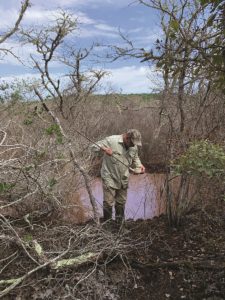WELLFLEET — For the Cape Cod Mosquito Control Project, late summer was all about whacking through shrubbery and spraying waterways with larvicide. But these measures have only nibbled at the edges of this year’s mosquito boom.
“We can only get to maybe 20 percent of the breeding habitat,” said Gabrielle Sakolsky, Mosquito Control’s entomologist and superintendent.
Sakolsky’s crews did received approval from the Cape Cod National Seashore to cut access paths to previously inaccessible water channels, but larvicide, it turns out, is only a short-term solution. Mosquito ditches, Sakolsky now proposes, are the long-term remedy. But Park scientists point out that the ditches have a complicated ecological history in the Herring River basin.
This summer’s scourges flourished after overwash from Cape Cod Bay spilled into the Herring River basin, greatly expanding mosquito breeding habitat. “We’re probably going to have more overwash events next spring,” Geoff Sanders, the chief of natural resource management and science at the Seashore, told the Independent. “And it’s likely there will be good habitat again.”
Unclogging the Flow
Branching out from the main stem of the Herring River, mosquito ditches were meant to keep water moving along, reducing the amount of standing water available for egg-laying. But those channels haven’t been maintained for decades. They’re congested with vegetation, and dead trees have tumbled into the water, impeding flow. These are the waterways Mosquito Control wants to unclog.
What past experience and scientific research show, however, is that the ditches and their maintenance contributed to massive fish die-offs in the 1980s, by churning up harmful compounds from salt marsh sediment.
In the fall of 1980, American eels were dying by the thousands in the Herring River. In post-mortem analyses conducted by the University of Rhode Island and the National Fisheries Service in Maryland, the eels’ gills and gastrointestinal tracts were found to be studded with lesions.
The alewife fishery fared no better: the Seashore was receiving local reports of die-offs among juvenile herring, particularly in the lower stretches of the river that emptied into Wellfleet Harbor.
Alarmed, Seashore scientists sampled the water and found asphyxiating conditions that spelled doom for fish. The lower Herring River was afflicted with deficient oxygen levels, particularly during the summer. In fact, during some stretches, the water was totally deoxygenated for weeks. John Portnoy, a retired Seashore ecologist who published these findings in 1991, suspected that the Chequessett Neck Road dike was responsible. The Herring River salt marshes teem with organic matter undergoing decomposition — a process that consumes immense amounts of oxygen.
“Under natural, undiked conditions, this oxygen is replaced by the daily supply of oxygen-rich waters,” Portnoy told the Independent — waters that would flow in from the harbor on incoming tides. The dike, however, stalled this cycle of replenishment.
Mosquito ditches worsened the problem in two ways: first, by creating a “deep organic sink” that further depleted dissolved oxygen, according to Portnoy’s 1991 paper. And further, Portnoy found extremely high sulfate levels in water emanating from these ditches.
Left undisturbed in salt marsh sediment, these compounds are benign, but active mosquito ditches can drain the soil, exposing them to air, and triggering a chemical reaction that unleashes toxic levels of sulfuric acid into streams. To make matters worse, high acidity can then mobilize excessive concentrations of aluminum from the sediment, intensifying water toxicity.
Progress for Herring
For all of these reasons, mosquito ditch maintenance was abandoned after 1984. The Herring River remains heavily monitored, and Tim Smith, currently the Seashore’s restoration ecologist, has noticed some progress. In the aftermath of the die-offs, the Seashore kept juvenile herring confined to Herring Pond during the summer, shielding them from oxygen-depleted waters. Now, the river’s oxygen budget is still low, but in the absence of ditch maintenance, conditions have improved enough for the herring to resume their normal migration from the pond.
But low oxygen and high acidity are persistent problems in some waterways, although they’re no longer as widespread throughout the floodplain. “Even with the absence of ditch maintenance, we’re still getting these really bad conditions for extended periods of time,” Smith said.

Given the history and current precariousness of the river’s health, the Seashore is wary of Mosquito Control’s proposal to clear the ditches. “The only way we can see this happening in an ecologically responsible way is to do it in concert with the Herring River Restoration Project,” said Smith. “Tidal exchange is the answer to all of these problems.”
Restoring tidal flushing would allow oxygen-rich seawater to replenish the estuary with every high tide and prevent organic buildup in the river. A regular influx of seawater would also neutralize sulfuric acid released by active mosquito ditches.
This regulated acidity would not only keep aluminum levels under control but also potentially disrupt an advantage that mosquitos have long wielded over fish predators. In the ’80s, Portnoy noticed that while elevated acidity completely excluded fish from large portions of the estuary, mosquitos showed reproductive success under these conditions. Keeping acidity at bay may level the playing field between predator and prey throughout the wetland system. As an added bonus, the river’s restoration may create small channels in the floodplain, granting fish greater access to mosquito breeding sites.
The Seashore is angling to submit a permit application to the Wellfleet Conservation Commission for the restoration project “sometime this year,” said Smith. Mosquito Control, in the meantime, is still working with the Seashore to figure out how to encourage water flow in the ditches without churning up too much sediment.
“You don’t want to release all those nasty things if you don’t have to,” Sanders told the Independent.



